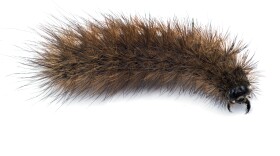
Bug Bytes
As described by Edward O. Wilson — perhaps the best known American biologist, researcher, naturalist and author — invertebrates are "The Little Things That Run the World." And indeed they do, in so many ways. In terms of numbers — while most invertebrates are pretty small, the sheer number of them is astounding. Together, they have more biomass than any other animal on earth.
Learn more about the fascinating creatures that run the world, with Bug Bytes from the Missoula Butterfly House and Insectarium.
-
Unlike most spiders, their bodies are long and stick-like, helping them blend into their surroundings. In addition, two of their eight eyes are large and forward-facing, giving them surprisingly good eyesight at night – even better than that of an owl. But it’s not their physical appearance or amazing night vision that make these spiders so unique, it’s how they use their web.
-
Most species of caterpillars will molt five times before entering the pupal stage – the last stage of development before transforming into an adult moth or butterfly. So what happens to all of those old exoskeletons?
-
With a name like Dracula Ant, you might venture a guess as to why this species received its common name. But rather than the image of a rogue ant roaming the landscapes of Southeast Asia and Australia in search of random victims, in reality they engage in “nondestructive cannibalism”, drinking the blood of their developing young without killing them. Creepy, but not deadly.
-
When you’re a small frog in the jungle, you best be on the lookout as you’re on the menu of a variety of other animals. At about a half inch in length, frogs in the family microhylid – known as narrow-mouthed frogs – certainly fall into that category. But thanks to the unusual relationship some of these frogs in Peru, India and Sri Lanka have developed with different species of rather large tarantulas, they have a unique defense …an eight-legged bodyguard.
-
The Western Amazon Ant is in a genus of ants commonly called Kidnapper Ants. They are obligatory social parasites – unable to feed themselves or even take care of the rest of the colony. To handle these essential tasks, they are reliant on a totally different species of ant in the genus Formica.
-
Aside from looking like a seed in shape, coloration, and size, the Australian Walking Stick’s eggs have evolved to have their own detachable cap (called a capitulum) that’s also prized by the hungry ants.
-
The weather-predicting myth of the Woolly Bear has been passed down since colonial times. The folklore holds that when you see a caterpillar in autumn, the thicker the reddish-brown stripe, the milder the winter ahead. If its coloration is dominated by the thicker black bands, then we’re in for a doozy of a winter.
-
Looking much like a roly-poly, a unique species of marine isopod is known to parasitize eight species of fish. And while it is not uncommon for fish to have parasites, this species is the only known pest to replace a host’s organ. Which organ, you might ask? We present, the tongue-eating louse.
-
When trying to avoid predators or find prey it’s helpful to look in all directions. But when you’re an animal that spends a lot of time at the surface of the water, it’s hard to do both at the same time …that is, unless you’re a whirligig beetle.
-
There are five different species of Hummingbird Clearwing Moths in the United States. Unlike most moths that are active at night, these members of the sphinx moth family fly during the day, making them much easier to observe than their nocturnal relatives.










